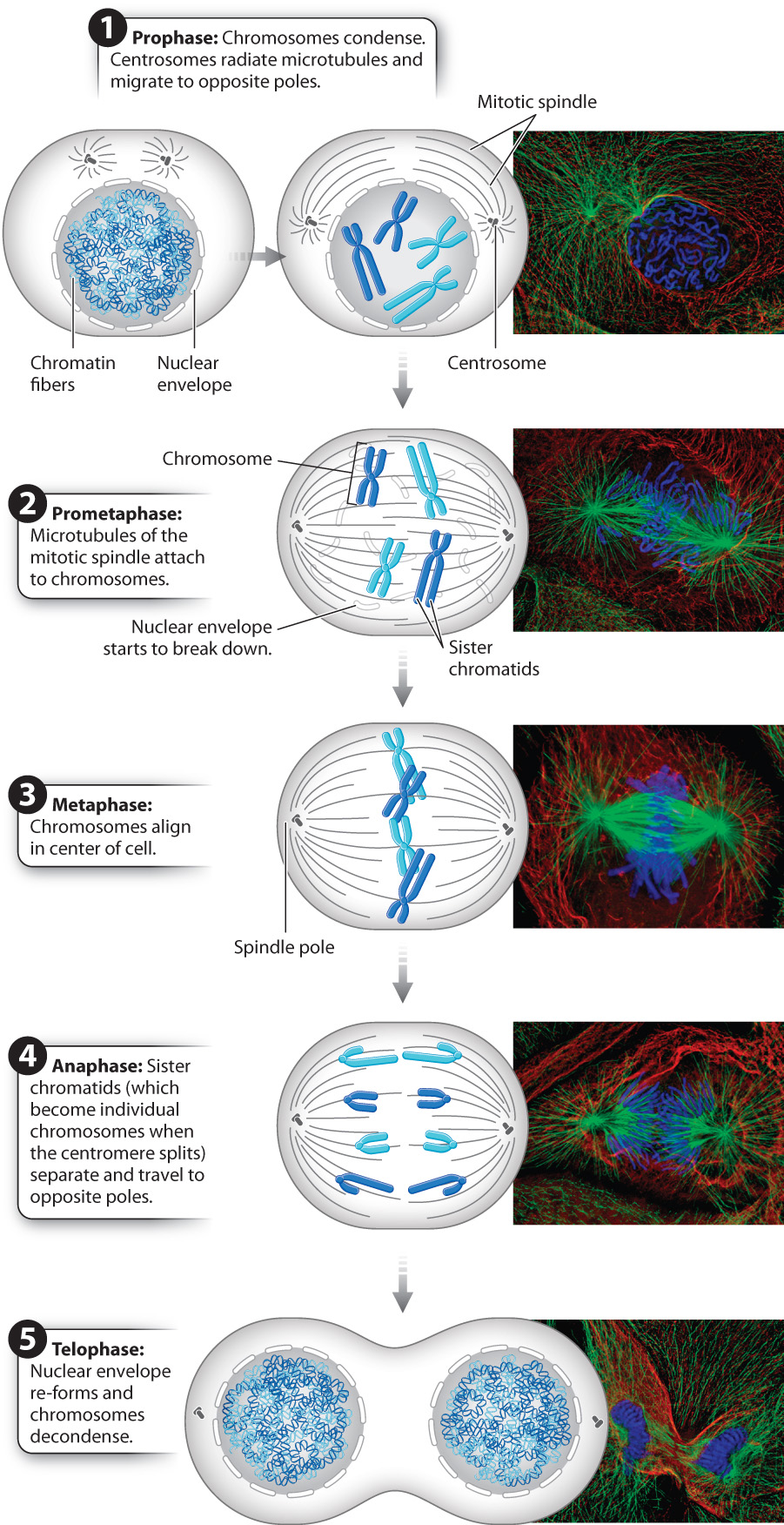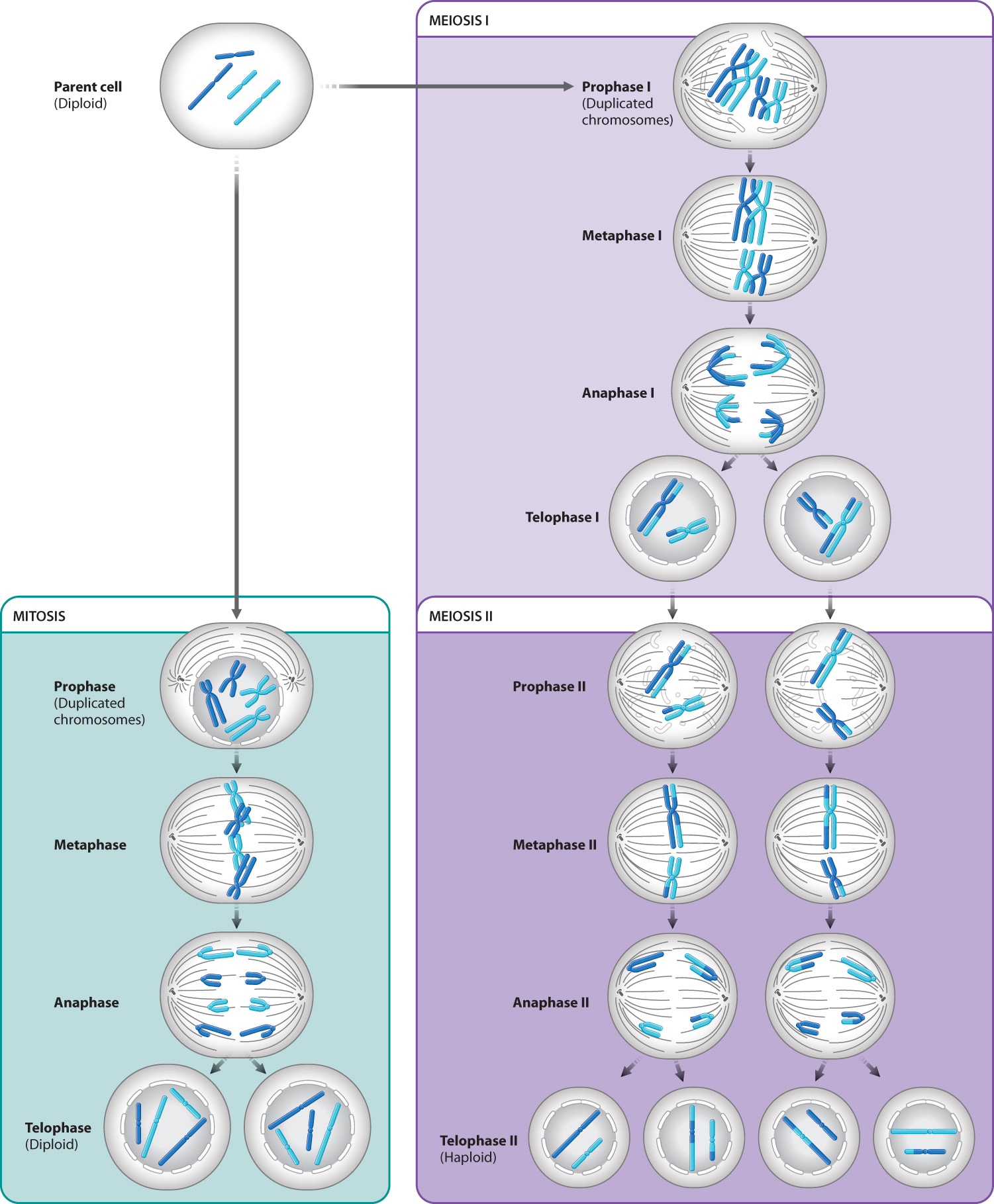CHAPTER SUMMARY
11.1 DURING CELL DIVISION, A SINGLE PARENTAL CELL DIVIDES INTO TWO DAUGHTER CELLS.
- Prokaryotic cells divide by binary fission, in which a cell replicates its DNA, segregates its DNA, and divides into two cells.
- Eukaryotic cells divide by mitosis (nuclear division) and cytokinesis (cytoplasmic division). Together, mitosis and cytokinesis are known as mitotic cell division.
- M phase (mitosis and cytokinesis) alternates with interphase, which consists of G1, S (synthesis), and G2 phases. These four stages together constitute the cell cycle.
- Cells that do not need to divide exit the cell cycle and are in G0.
11.2 MITOTIC CELL DIVISION IS THE BASIS OF ASEXUAL REPRODUCTION IN UNICELLULAR EUKARYOTES AND THE PROCESS BY WHICH CELLS DIVIDE IN MULTICELLULAR EUKARYOTES.
- DNA in a eukaryotic cell is packaged as linear chromosomes.
- Humans have 46 chromosomes: 22 pairs of homologous chromosomes and one pair of sex chromosomes. Each parent contributes one complete set of 23 chromosomes at fertilization.
- During S phase, chromosomes replicate, resulting in the formation of sister chromatids held together at the centromere.
- Mitosis involves five steps following DNA replication: (1) prophase—the chromosomes condense and become visible under the light microscope; (2) prometaphase—the microtubule spindles attach to the centromeres; (3) metaphase—the chromosomes line up in the middle of the cell; (4) anaphase—the centromeres divide and the chromosomes move to opposite poles; and (5) telophase—the nuclear envelope re-forms and chromosomes decondense.
- Mitosis is followed by cytokinesis, in which one cell divides into two. In animals, a contractile ring of actin pinches the cell in two. In plants, a new cell wall, called the cell plate, is synthesized between the daughter cells.
11.3 MEIOTIC CELL DIVISION IS ESSENTIAL FOR SEXUAL REPRODUCTION, THE PRODUCTION OF OFFSPRING THAT COMBINES GENETIC MATERIAL FROM TWO PARENTS.
- Sexual reproduction involves meiosis and fertilization, both of which are important in increasing genetic diversity.
- Meiotic cell division is a form of cell division that reduces the number of chromosomes by half to produce haploid gametes or spores that have one copy of each chromosome.
- Fertilization involves the fusion of haploid gametes to produce a diploid cell.
- Meiosis consists of two successive cell divisions: The first is reductional (the chromosome number is halved), and the second is equational (the chromosome number stays the same). Each division consists of prophase, metaphase, anaphase and telophase.
- In meiosis I, homologous chromosomes pair and exchange genetic material at chiasmata, or regions of crossing over. In contrast to mitosis, centromeres do not divide and sister chromatids do not separate.
- Genetic diversity is generated by crossing over and random alignment and subsequent segregation of maternal and paternal homologs on the metaphase plate in meiosis I.
- Meiosis II is similar to mitosis, in which chromosomes align on the metaphase plate, centromeres divide, and sister chromatids separate from each other.
- The similarity of meiosis II and mitosis suggests that meiosis evolved from mitosis.
- The division of the cytoplasm differs between the sexes: Male meiotic cell division produces four functional sperm cells, whereas female meiotic cell division produces a single functional egg cell and three polar bodies.
11.4 THE CELL CYCLE IS REGULATED SO THAT CELL DIVISION OCCURS ONLY AT APPROPRIATE TIMES.
- Levels of proteins called cyclins increase and decrease during the cell cycle.
- Cyclins form complexes with cyclin-dependent kinases (CDKs), activating the CDKs to phosphorylate target proteins involved in cell division.
- Different cyclin–CDK complexes control progression through the cell cycle at key steps, including G1/S phase, S phase, and M phase.
- These complexes can be inhibited at key checkpoints, halting progression through the cell cycle if something is not right.
11.5 CANCER IS UNCONTROLLED CELL DIVISION THAT USUALLY RESULTS FROM MUTATIONS IN GENES THAT CONTROL CELL DIVISION.
- Cancers can be caused by certain viruses carrying oncogenes that promote uncontrolled cell division, although most cancers are not caused by viruses.
- Viral oncogenes have cellular counterparts called proto-oncogenes that play normal roles in cell growth and division and that, when mutated, can cause cancer.
- Oncogenes and proto-oncogenes often encode proteins involved in signaling pathways that promote cell division.
- The normal cellular role of tumor suppressor proteins, such as p53, is to block cell division and inhibit cancers.
- Cancers usually result from several mutations in proto-oncogenes and tumor suppressor genes that have accumulated over time within the same cell.
Self-Assessment Question 1
Compare and contrast the ways in which prokaryotic cells and eukaryotic cells divide.
Show Model Answer
Model Answer:
Prokaryotic cells reproduce through a process called binary fission. During this process, the cell replicates its DNA, increases in size, and divides into two daughter cells, each having one copy of the parental DNA. Eukaryotic cells go through a similar process, albeit more complex, called mitotic cell division. In this process, cells first replicate their chromosomes in the nucleus. The nuclear envelop then dissolves and each pair of chromosomes are divided by connecting to the mitotic spindle. Once the two full sets of chromosomes are separated, a nuclear envelope forms around each one. The cell then goes through a process called cytokinesis, where it is split into two new daughter cells.
Self-Assessment Question 2
Describe three situations in which mitotic cell division occurs.
Show Model Answer
Model Answer:
Three situations in which mitotic cell division occurs are in the development of multicellular organisms, maintenance and repair of organs and tissues, and asexual reproduction of unicellular eukaryotes.
Self-Assessment Question 3
Name the five steps of mitosis, and draw the changes in the structure and position of the chromosomes at each step.
Show Model Answer
Model Answer:
The five steps in mitosis are: (1) Prophase (chromosomes condense, centrosomes radiate microtubules and migrate to opposite poles), (2) Prometaphase (microtubules of the mitotic spindle attach to chromosomes), (3) Metaphase (chromosomes align in center of cell), (4) Anaphase (sister chromatids separate and travel to opposite poles), and (5) Telophase (nuclear envelope re-forms and chromosomes decondense).
See Figure 11.5 for an illustration of the changes in the chromosomes at each step.

Self-Assessment Question 4
Describe how chromosomes behave in meiosis. Be able to state when chromosomes are duplicated (forming sister chromatids) and when they are not duplicated.
Show Model Answer
Model Answer:
Meiosis basically goes through two cell-division cycles called meiosis I and meiosis II. In meiosis I, chromosomes are duplicated in Prophase I forming sister chromatids. In Anaphase I, homologous chromosomes separate into two different daughter cells. During meiosis II, the chromosomes do not duplicate and instead the sister chromatids are separated into two more daughter cells. The end result of this process is four daughter cells, each having unique genetic information.
Self-Assessment Question 5
Compare and contrast mitotic cell division and meiotic cell division in terms of number of products, number of cell divisions, and processes unique to each.
Show Model Answer
Model Answer:
Mitosis goes through one round of DNA synthesis to produce two genetically identical daughter cells, each with 46 chromosomes. Meiosis also goes through one round of DNA synthesis but goes through two rounds of cell division to produce four genetically different daughter cells, with 23 chromosomes each. See Figure 11.12.

Self-Assessment Question 6
Name two ways in which meiotic cell division creates genetic diversity, and explain how each occurs.
Show Model Answer
Model Answer:
Genetic diversity is created in meiotic cell division by the crossing over of chromosomes and random alignment of bivalents in metaphase I. Crossing over occurs when homologous chromosomes of maternal origin and paternal origin undergo an exchange of DNA segments, thus creating genetic diversity. Random alignment of bivalents leads to a chromosome set that is a random mix of maternal and paternal homologs.
Self-Assessment Question 7
Explain how cytokinesis differs between animal and plant cells.
Show Model Answer
Model Answer:
In animal cells, cytokinesis involves a contractile ring made of actin. In plant cells, it involves the growth of a new cell wall called a cell plate.
Self-Assessment Question 8
Describe the roles of cyclins and cyclin–dependent kinases in the cell cycle.
Show Model Answer
Model Answer:
In the cell cycle, cyclins bind to and activate cyclin-dependent kinases (CDKs). Once activated, the CDKs then phosphorylate target proteins involved in promoting cell division. Once activation has occurred, the CDK dissociates from the cyclin and the cyclin degrades.
Self-Assessment Question 9
Give three examples of checkpoints that the cell monitors before proceeding through the cell cycle.
Show Model Answer
Model Answer:
Three examples of checkpoints during the cell cycle are (1) Spindle assembly checkpoint, which happens before anaphase and ensures that all chromosomes are attached to the spindles; (2) DNA damage checkpoint, which happens in the G1 phase and checks for DNA damage; and (3) DNA replication checkpoint, which happens in G2 and makes sure all the DNA is replicated.
Self-Assessment Question 10
Describe the differences among a proto-oncogene, an oncogene, and a tumor suppressor gene.
Show Model Answer
Model Answer:
An oncogene is a gene that causes cancer. A proto-oncogene is a gene that has the potential to cause cancer when mutated. A tumor suppressor gene blocks specific steps in the development of cancer.